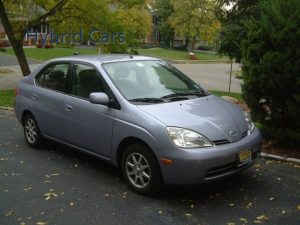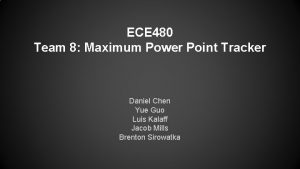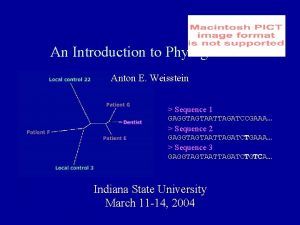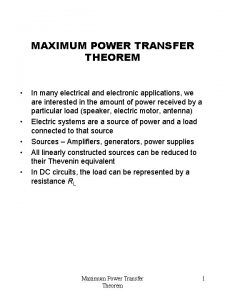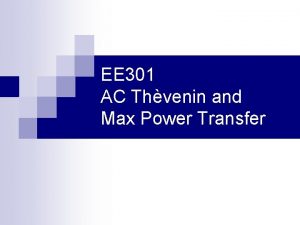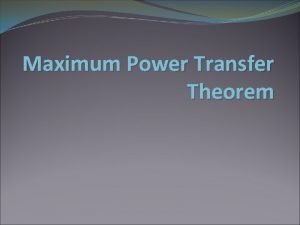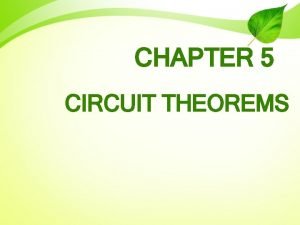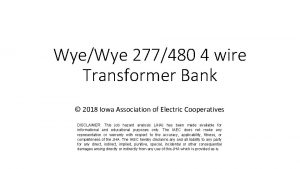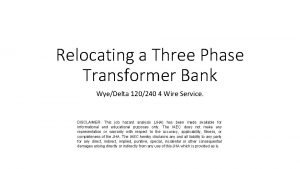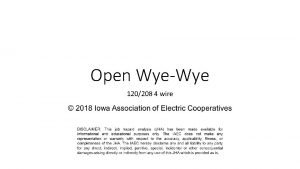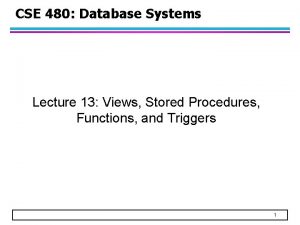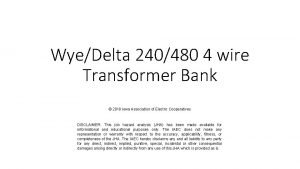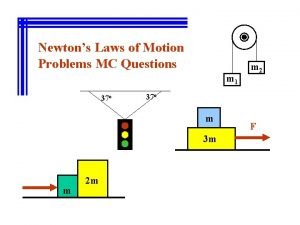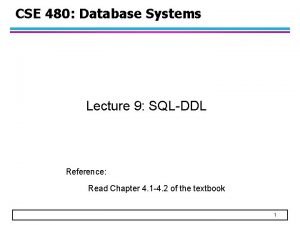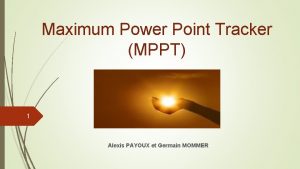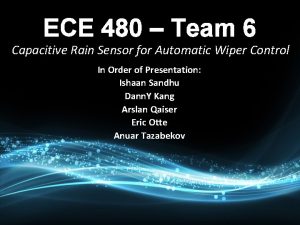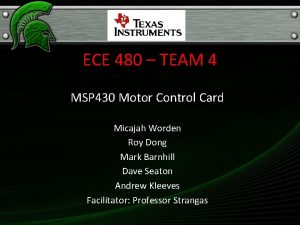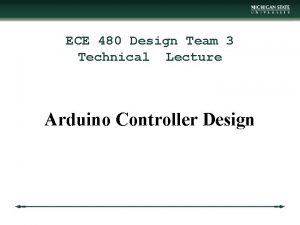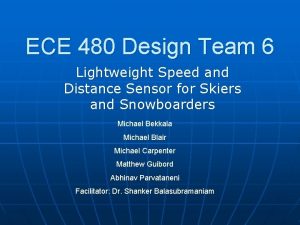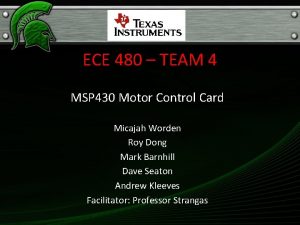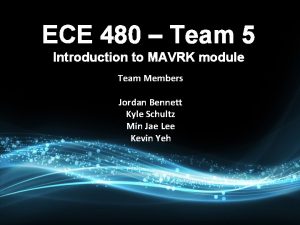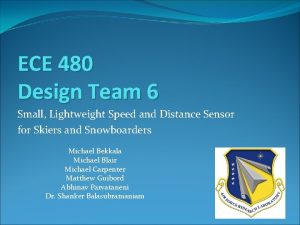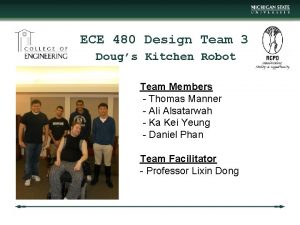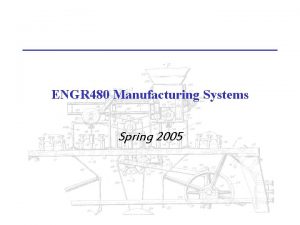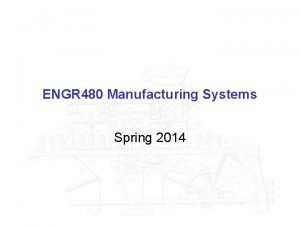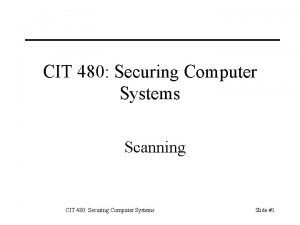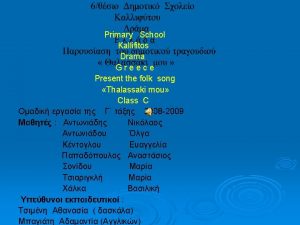ECE 480 Team 8 Maximum Power Point Tracker
































- Slides: 32

ECE 480 Team 8: Maximum Power Point Tracker Daniel Chen Yue Guo Luis Kalaff Jacob Mills Brenton Sirowatka

Our Team Name Responsibility Daniel Chen Presentation Preparation Yue Guo Lab Coordinator Luis Kalaff Project Management Jacob Mills Project Webmaster Brenton Sirowatka Documentation Preparation

Presentation Objectives 1. ● ● ● Introduction Background Real World Applications Available Solutions 3. ● ● ● Implementation Microcontroller Voltage and Current Sensing Testing Strategies 2. ● ● ● Project Objectives Customer Expectations Design Approach Design Stages 4. ● ● ● Project Management Technical Responsibilities Gantt Chart Fast Diagram

Background ● What is a Maximum Power Point Tracker? o Maximizes power from solar cells o The device finds the point on the I-V curve where Maximum Power is given. o The MPPT matches the low voltage of the solar array to the high voltage of the battery

Background There are eight types of methods for tracking the maximum power point: 1. Perturb and Observe 2. Incremental Conductance 3. Current Sweep 4. Constant Voltage 5. Open Circuit Voltage 6. Short Circuit Current 7. Temperature 8. Temperature Parametric We decided to use the Perturb and Observe method.

Background

Background Perturb and Observe Method: ● Increases input voltage continuously ● Current begins to drop as voltage increases ● Once current drops to far the voltage is then lowered back to the point where maximum power is achieved. ● The device then oscillates around the maximum power point.

Real World Applications ● MPPTs are used in any product that contains a solar cell. o Cars, batteries, buses, landscaping, pools, boats, etc. ● Also used in optical power transmission systems o Method for replacing copper wiring with fiber optic cables. o power is transmitted into light and sent through fiber optic cable. o Cell converts light back to electricity and sufficient voltage is acquired using MPPT.

Available Solution ● Previously the Solar Car Racing Team used the Dilithium Power Systems ‘Photon Quad MPPT. ’ o Boost Ratio: 1 to 14 o contains 160 V battery o Used CAN based communication ● Features 4 independent channels and is optimized for several kinds of solar arrays.

Customer Expectations ● ● ● Greater than 95% efficiency One channel Input voltage 20 to 60 Volts Output voltage ~110 Volts Withstand 6 Amps of current Single PCB

Design Approach

FAST Diagram

Design Stages DC-DC Boost Converter Microcontroller Tracking PCB Layout

DC-DC Boost Converter Convert the lower voltage from the solar array to match the higher voltage of the battery Solar Array Battery

PSpice DC-DC Boost Simulation

Microcontroller Tracking An algorithm is implemented to find the maximum powerpoint by adjusting the voltage slightly. The team chose to implemented the “perturb and observe” method for maximum power tracking.

Microcontroller ● Using C 2000 Piccolo launchpad ● 12 bit ADC, 8 PWM channels ● 60 MHz Frequency

Microcontroller

Voltage & Current Sensing ● Via Microcontroller ● Voltage Divider/Current Resistor Sensing

Sensing Implementation ● Microcontroller ● Utilize analog-digital converter ● Input constraints ○ Need to drop the output voltage from the Solar Array

Sensing Implementation Voltage Divider Sensor ● ● Vout = Vin*(R 2/(R 1+R 2)) Power loss Non Constant Input Alternative Vin Vout

Sensing Implementation Current Resistor Sensor ● Low ohm Resistor ● Less power loss

PCB Board Combine the analog and the digital part of our design into one single PCB board

Testing Strategies ● Use a smaller power supply and lower voltages o eg. Lab Bench Power supply ● Limited current for safety

Technical Responsibilities Name Responsibility 1 Responsibility 2 Responsibility 3 Selection & Ordering Calculation & Simulations Prototyping & Refinement Daniel Chen Resistor Risk Analysis Data Building/Testing Prototype Yue Guo Magnetic Core PCB Layout Building/Testing Prototype Luis Kalaff Microcontroller Labview DC-DC Booster Building/Testing Prototype Jacob Mills Diode Inductor Core & Windings Programming Microcontroller Brenton Sirowatka Capacitor PSpice DC-DC Circuit Programming Microcontroller

Budget Design Stages Cost DC-DC Boost Converter $40 Microcontroller $20 PCB Layout $60 Miscellaneous $20

Gantt Chart Tasks

Gantt Chart Refinement Design Prototype

Final Design Blueprint

Special Thanks to ● Everyone in the MSU Solar Car Team ○ Ian Grosh ○ Steve Zajac ○ Scott O’Connor ● Dr. Bingsen Wang (Faculty Advisor) ● Brian, Gregg, and Roxanne (ECE Shop)

Question?

Thank You
 480+480
480+480 Ece 480
Ece 480 Photovoltaic array maximum power point tracking array
Photovoltaic array maximum power point tracking array Ece tracker
Ece tracker Critical numbers
Critical numbers Maximum parsimony vs maximum likelihood
Maximum parsimony vs maximum likelihood Maximum likelihood vs maximum parsimony
Maximum likelihood vs maximum parsimony Active power reactive power apparent power
Active power reactive power apparent power Informsu
Informsu Point point power
Point point power Maximum power transfer theorem
Maximum power transfer theorem Maximum power transfer theorem
Maximum power transfer theorem Maximum power transfer formula
Maximum power transfer formula Maximum power transfer calculator
Maximum power transfer calculator Monochromatic emissive power formula
Monochromatic emissive power formula Solve the equation
Solve the equation Maximum power transfer theorem
Maximum power transfer theorem L matching network
L matching network Phantom graphs
Phantom graphs Team spirit becomes team infatuation
Team spirit becomes team infatuation Team spirit becomes team infatuation
Team spirit becomes team infatuation The white team cheers for the blue team, just like
The white team cheers for the blue team, just like 277 480 transformer bank
277 480 transformer bank Closed delta transformer bank
Closed delta transformer bank 120/208 wye wye bank
120/208 wye wye bank Mamin'ny foko
Mamin'ny foko Cse480
Cse480 240/480 transformer bank
240/480 transformer bank William morris wallpaper - hyacinth, pattern #480
William morris wallpaper - hyacinth, pattern #480 Newton's laws of motion problems
Newton's laws of motion problems Mk 480
Mk 480 The scratch stage is 480 pixels wide and 360 pixels high
The scratch stage is 480 pixels wide and 360 pixels high Cse 480 msu
Cse 480 msu
